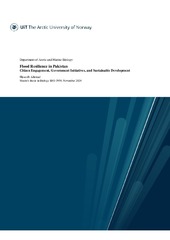| dc.description.abstract | This thesis analyses the impact of climate change, coupled with inadequate disaster
management, on the rising frequency and severity of floods in Pakistan. The thesis focuses on
the causes, socioeconomic impact, and government responses to floods by examining the
interaction of natural and human elements. Due to the complexity of the research question, we
have applied a multidisciplinary approach. The research draws on empirical climate data,
community interviews, and policy analysis to propose a comprehensive strategy for effective
flood mitigation in Pakistan.
The climate data analysis from Punjab province shows that rainfall is not the only cause of the
floods; rather, it is accompanied by other factors like poor infrastructure, glacial melting, and
upstream flow of water in the rivers. Citizen interviews highlight the severe social and
economic repercussions of floods, including displacement, health risks, educational disruption,
and agricultural loss. Women and children, in particular, face additional challenges, aggravated
by cultural and economic constraints. The government’s response, though well-intentioned, is
often criticised for inadequate infrastructure, weak policy enforcement, and lack of public
awareness campaigns.
The thesis findings highlight the need for a comprehensive flood management strategy. Stricter
land-use regulations, the development of early warning systems, raising public awareness, and
the improvement of infrastructure like dams and drainage systems are among the
recommendations. Additionally, community-led initiatives and international collaborations are
fundamental for building resilience. This study concludes that a multi-layered approach
combining structural, policy-based, and community-centred strategies is vital for mitigating
flood risks and adopting sustainable development in Pakistan. | en_US |


 English
English norsk
norsk
